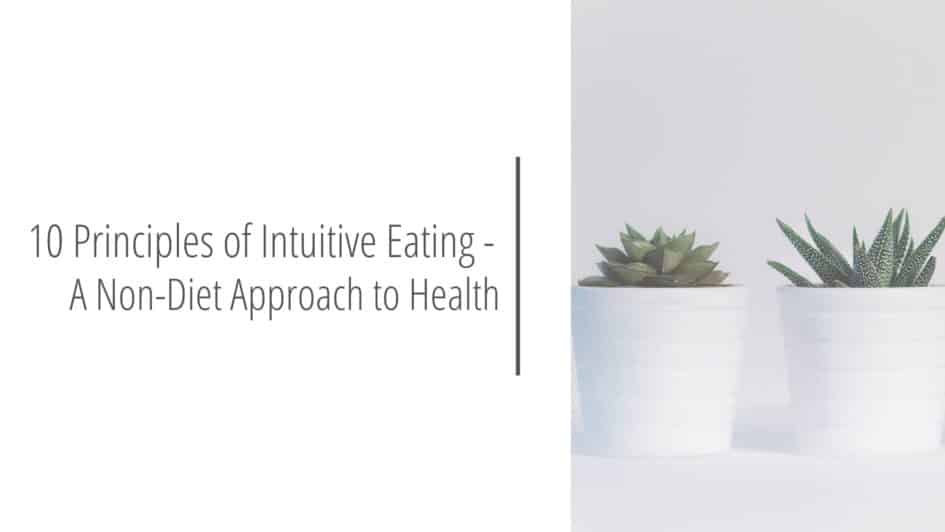Table of Contents
The Origins of Intuitive Eating
Before diving into the 10 principles of Intuitive Eating (IE), it’s important to know where the framework originated. IE was created by two registered dietitians (RDs), Evelyn Tribole and Elyse Resch (1). Both of these RDs specialize in eating disorders and strive to help people develop a healthy relationship with food and body.
Intuitive Eating is an evidenced-based, mind-body approach to health that uses a non-diet and weight-neutral model. It’s important to note that Intuitive eating is not a diet. Instead, it is a non-restrictive framework that helps you connect with your body’s needs and become the expert of your own body.
It was created to be a tool of empowerment to help free people from diet culture and weight obsession. The goal is to leave dieting, food restriction, body dissatisfaction, and weight stigma behind in order to pursue overall health and wellness.
10 Principles of Intuitive Eating
At the core of Intuitive Eating, there are 10 principles to help guide us through the process (2).
1. Reject the Diet Mentality
This means forgetting and facing the lies diet culture teaches, even if the process is painful. It’s time to ditch the fad diets, the calorie counting, and the restrictive behaviors that we have all been taught. Leaving the diet mentality behind is key when it comes to a successful Intuitive Eating practice.
2. Honor Your Hunger
Eat!
Our bodies need to be adequately nourished with energy through consuming carbohydrates (Yep, you read that right!), protein, and fat. Learning to listen and act according to your hunger is an important step in the process of healing your relationship with food and body.
3. Make Peace with Food
Yep, it’s that time! I know it sounds scary but you won’t regret it.
One of the most important practices in Intuitive Eating to learn is give yourself unconditional permission to eat. Restricting yourself of certain foods can lead to an unhealthy relationship with those foods. This can lead to uncontrollable cravings and binge eating, which often result in guilt and remorse.
4. Challenge the Food Police
The “Food Police” are the thoughts and people that monitor the rules that diet culture has created.
We have to learn to re-program our thoughts when it comes to “good” food vs “bad” food. With Intuitive Eating, restricting calories is no longer considered “good” and enjoying a cookie is no longer considered “bad.” It is important that we leave these thoughts behind.
6. Feel Your Fullness
We need to respect our hunger but also respect our fullness.
This is where we learn how our body feels when we are comfortably full. At what point during our meal do we stop and call it quits? This is not meant to be a restrictive behavior. Rather, this is meant to help us listen to our bodies and prevent overeating, which can often lead to guilt and compensatory behaviors.
6. Discover the Satisfaction Factor
When was the last time you ate a meal purely for the nutritional benefits it provided? When was the last time you ate a meal for the pleasure and satisfaction that it provided? How about both?
Eating what we desire, in an inviting and peaceful environment, helps us feel satisfied and content. Thus, leading to a healthier relationship with food and body.
7. Cope with Your Emotions with Kindness
What are ways, other than food, that you can find comfort and resolve problems?
While food may provide comfort and resolution for a short period of time, it won’t solve the overarching problem. Intuitive Eating focuses on finding long-term ways to cope with life’s difficulties that don’t involve food.
This helps us view food as a positive experience used to nourish our bodies instead of as a tool to drown out our emotions and hardships.
8. Respect Your Body
Bodies come in all shapes, sizes, and colors. It’s called body diversity and it’s a beautiful thing!
You cannot determine a person’s health by looking at their external appearance. I repeat… you cannot determine a person’s health by looking at their external appearance. Thin ≠ healthy. Fat ≠ unhealthy.
Health can be achieved at every size. It is important that we learn to respect and cherish our bodies regardless of shape, weight, or other “imperfections.”
9. Movement—Feel the Difference
Participate in joyful, intuitive movement! If your goal is calories burnt instead of healthful benefits received, you may need to re-evaluate why you’re participating in a certain exercise.
Find ways that you enjoy moving. Dancing? Hiking? Yoga? Walks at the park? Classes at the gym? Workouts with friends? Lifting weights? Cardio? The options are endless.
Join me on Instagram every Monday for Movement Mondays, where I encourage you to practice joyful movement each week!
10. Honor Your Health—Gentle Nutrition
When choosing foods, choose those that honor your health and your taste buds. Choose foods that you make you feel your best, physically and mentally. Always remember that you do not have to eat the “perfect diet” in order to live a healthy life.
Gentle nutrition is the final principle of Intuitive Eating and a very important one. People will often choose to implement gentle nutrition into their IE practice last, to ensure they have the other 9 principles down before diving into nutrition.
Research Studies about Intuitive Eating
Not quite convinced that Intuitive Eating is a good option? Then keep reading. Below you will find summaries of research articles about Intuitive Eating and its efficacy. Feel free to link to the article itself to read an in-depth explanation!
Research Example 1
A brief summary:
This experimental study involved 124 total (after exclusion) female participants divided into an intervention group (n=53) and a control group (n=71).
The intervention group underwent a 10-week Eat for Life class (a combination of intuitive eating and mindfulness approaches) while the control group was placed on the program waitlist.
The purpose of this study was to determine the difference between the two groups when it comes to body appreciation, problematic eating behaviors, intuitive eating, and mindfulness.
The results showed that the women in the 10-week Eat for Life program reported higher levels of body appreciation and lower levels of problematic eating behaviors in comparison to the waitlist group (3)
Research Example 2
A brief summary:
This study included 322 female undergraduate students with ages ranging from 18 to 24 years old.
The purpose of this study was to determine the correlation between intuitive eating and self-compassion, distress, and body image acceptance.
The participants completed various online surveys including the Self-compassion Scale (SCS), the Distress Tolerance Scale (DTS), the Body Image Acceptance and Action Questionnaire (BI-AAQ), the Intuitive Eating Scale (IES), and the Rosenberg Self-Esteem Scale (RSES).
The results showed that participants that scored higher on self-compassion reported higher levels of intuitive eating, distress tolerance, and body image flexibility. The results also showed that participants that reported higher levels of intuitive eating tended to report higher levels of body image acceptance (4).
Research Example 3
A brief summary:
This experimental study involved a total of 801 women separated into three different groups: emerging adulthood group (18-25 years old, n=318), an early adulthood group (26-39 years old, n=238) and a middle adulthood group (40-65 years old, n=245).
Participants completed various surveys that assessed support systems, body acceptance, level of intuitive eating, personal view of other women’s bodies, perception of body shape/size, overall life satisfaction, and other topics.
The results indicated an increase in perceived social support was associated with body acceptance of others as well as an increase in body appreciation and intuitive eating when others approved of their bodies. It was also found that BMI negatively impacted a woman’s appreciation of her own body (5).
Research Example 4
A brief summary:
This 2-year pilot study involved 120 participants and was conducted at an inpatient-residential care facility for women with anorexia nervosa, bulimia nervosa, binge eating, eating disorder-not other specified, and additional comorbid diagnoses.
The purpose of this study was to determine if teaching eating disorder patients the concepts of intuitive eating would improve the patient’s outcomes.
The participants received education on the 10 main intuitive eating principles and registered dietitians met with the patients individually each week to discuss the principles. The results showed that the participants developed healthier attitudes towards food/eating and learned to apply the principles to make healthier choices (6).
Quick Summary
To summarize, the 10 principles of Intuitive Eating include:
- Reject the Diet Mentality
- Honor your Hunger
- Make Peace with Food
- Challenge the Food Police
- Feel Your Fullness
- Discover the Satisfaction Factor
- Cope with Your Emotions with Kindness
- Respect Your Body
- Movement – Feel the Difference
- Honor Your Health – Gentle Nutrition
Each principle is just as important as the next. Research demonstrates that implementing these 10 principles could help you develop a healthier relationship with food and body.
Dig Deeper
If you would like to dig deeper into Intuitive Eating, I recommend grabbing a copy of Intuitive Eating – A Revolutionary Anti-Diet Approach, 4th Edition by Evelyn Tribole and Elyse Resch. It can be found where books are sold, including Amazon. The official Intuitive Eating Website is also a great resource.
For additional reading, check out the Intuitive Eating section on my website. Whether you’re a newbie intuitive eater or a seasoned one, take a look at my anti-diet themed store for fun Intuitive Eating products!
Thanks for reading!
Rachel Beiler, MHS, RD, LDN
References
Intuitive Eating: A Revolutionary Anti-Diet Approach, 4th Edition by Evelyn Tribole & Elyse Reschda


8 Pingbacks